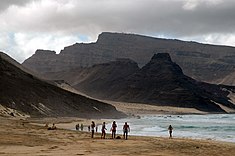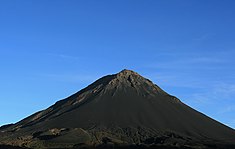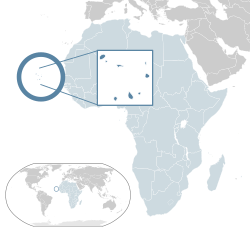Cape Verde
Republic of Cabo Verde | |
|---|---|
Motto:
| |
| Anthem: Cântico da Liberdade (Portuguese) (English: "Chant of Freedom") | |
| Capital and largest city | Praia 14°55′N 23°31′W / 14.917°N 23.517°W |
| Official languages | Portuguese |
| Recognised national languages | Cape Verdean Creole |
| Religion |
|
| Demonym(s) | Cape Verdean or Cabo Verdean[2] |
| Government | Unitary semi-presidential republic[3] |
| José Maria Neves | |
| Ulisses Correia e Silva | |
| Legislature | National Assembly |
| Formation | |
• Independence from Portugal | 5 July 1975 |
| 13 January 1990 | |
| Area | |
• Total | 4,033 km2 (1,557 sq mi) (166th) |
• Water (%) | negligible |
| Population | |
• 2021 estimate | 587,925[4][5] (172nd) |
• Density | 123.7/km2 (320.4/sq mi) (89th) |
| GDP (PPP) | 2019 estimate |
• Total | $4.323 billion |
• Per capita | $7,728[6] |
| GDP (nominal) | 2019 estimate |
• Total | $2.042 billion |
• Per capita | $3,651[6] |
| Gini (2008) | 47.2[7] high |
| HDI (2019) | medium · 126th |
| Currency | Cape Verdean escudo (CVE) |
| Time zone | UTC–1 (CVT) |
• Summer (DST) | UTC–1 (not observed) |
| Driving side | right |
| Calling code | +238 |
| ISO 3166 code | CV |
| Internet TLD | .cv |
Cape Verde (/ˈvɜːrd(i)/ (![]() listen)) or Cabo Verde (/ˌkɑːboʊ ˈvɜːrdeɪ/ (
listen)) or Cabo Verde (/ˌkɑːboʊ ˈvɜːrdeɪ/ (![]() listen), /ˌkæb-/) (Portuguese: Cabo Verde, pronounced: [ˈkabu ˈveɾdɨ]), officially the Republic of Cabo Verde,[10] is an island country in Africa. It is a group of islands in the Atlantic Ocean, 570 km (354 mi) off the coast of Western Africa. The islands cover a combined area of slightly over 4,000 km2 (1,500 sq mi). They have a volcanic origin.
listen), /ˌkæb-/) (Portuguese: Cabo Verde, pronounced: [ˈkabu ˈveɾdɨ]), officially the Republic of Cabo Verde,[10] is an island country in Africa. It is a group of islands in the Atlantic Ocean, 570 km (354 mi) off the coast of Western Africa. The islands cover a combined area of slightly over 4,000 km2 (1,500 sq mi). They have a volcanic origin.
Cape Verde is one of Macaronesia's group of islands.
Name
[change | change source]The Portuguese explorer Dinis Dias (or Denis Fernadez) discovered in 1445 a peninsula along the coast of Senegal that he named Cap-Vert (Dias named it Cabo Verde, "verde" being Portuguese for "green", a reference to the vegetation in the area). Dias did not discover the Cape Verde Islands, but rather the actual cape.[11]
This peninsula is the westernmost point of the African continent.
History
[change | change source]
The first Europeans to arrive in Cape Verde were the Portugueses Diogo Gomes and Antonio da Noli in 1460. The islands were uninhabited, and the first settlement was founded in 1462 on the island of Santiago (the main Island) which was divided into two “capitanias”, Alcatrazes and Ribeira Grande. The first one failed and the main activity in Ribeira Grande was the exploitation of cotton farms. Ribeira Grande served also as a slave trade post and as post of slave Christianization before they were sent to the New World.
The city suffered several pirate raids and for this reason in 1712, after a French attack, the authorities were forced to move the capital to Praia, where it is located until now. Cape Verde had the status of Portuguese colony until 1951 when Portugal changed its status to Overseas Province and in 1961 Portugal gave full citizenship to all Cape Verdeans.
Cape Verde has been independent of Portugal since 5th July 1975. The fight for independence was led by the African Party for the Independence of Guinea and Cape Verde (PAIGC) and headed by Amílcar_Cabral, the national hero of both countries, Cape Verde and Guinea-Bissau.
Geography
[change | change source]


The Cape Verde archipelago is in the Atlantic Ocean, approximately 570 km (350 mi) off the coast of West Africa, near Senegal, Gambia and Mauritania, and is a part, together with the Azores, Madeira, Savage Islands and Canary Islands, of the Macaronesia ecological region.[12] It lies between the latitudes 14°N and 18°N, and the longitudes 22°W and 26°W.
The country is an archipelago with a total area of 4,033 km2 (1,557 sq mi). It is formed by ten islands (nine inhabited) and several very small islands (islets) divided into two groups, arranged according to the prevailing wind direction:
- To the north, the Ilhas de Barlavento (Windward islands), from west to east: Santo Antão, São Vicente, Santa Luzia (without inhabitants), São Nicolau, Ilha do Sal and Boa Vista; and the islets of Branco and Raso, situated between Santa Luzia and São Nicolau, the islet of Pássaros, opposite the town of Mindelo on the island of São Vicente, and the islets Rabo de Junco, on the coast of the Sal island and the islets Sal Rei and Baluarte, on the coast of the island of Boa Vista.
- To the south Ilhas de Sotavento (Leeward islands), from east to west: Maio, Santiago, Fogo and Brava; and the islet of Santa Maria, in front of the city of Praia, on Santiago island, the islets Grande, Rombo, Baixo, Cima, do Rei, Luís Carneiro and Sapado, situated about 8 km from the island of Brava, and the islet Areia along the coast of the same island.
The largest islands are, to the southeast, Santiago, where lies Praia, the capital and largest city of the country, and the island of Santo Antão, in the extreme northwest. Praia is also the main population centre of the archipelago, followed by Mindelo on the island of São Vicente.
| Name | Population (2010)[13] |
Area (km²) |
Highest point (m) |
|---|---|---|---|
| Boa Vista | 9,162 | 620 | Monte Estância (387) |
| Brava | 5,995 | 67 | Monte Fontainhas (976) |
| Fogo | 37,051 | 476 | Pico do Fogo (2,829) |
| Maio | 6,952 | 265 | Monte Penoso (436) |
| Sal | 25,765 | 216 | Monte Vermelho (406) |
| Santa Luzia | 0 | 35 | Monte Grande (395) |
| Santiago | 273,919 | 991 | Pico d'Antónia (1,394) |
| Santo Antão | 43,915 | 779 | Topo de Coroa (1,979) |
| São Nicolau | 12,817 | 388 | Monte Gordo (1,340) |
| São Vicente | 76,107 | 227 | Monte Verde (774) |
Extreme points
[change | change source]- N North: Ponta do Sol, Santo Antão island 17°11′0″N 25°05′0″W / 17.18333°N 25.08333°W
- S South: Ponta Nhô Martinho, Brava island 14°49′0″N 24°42′0″W / 14.81667°N 24.70000°W
- E East: Ilhéu do Roque, Boa Vista island 16°05′0″N 22°40′0″W / 16.08333°N 22.66667°W
- W West: Ponta Chão de Morgado, Santo Antão island 17°03′0″N 25°21′0″W / 17.05000°N 25.35000°W
- H Highest mountain: Pico do Fogo, Fogo island, 2,829 m (9,281 ft) high 14°57′0″N 24°20′0″W / 14.95000°N 24.33333°W
Climate
[change | change source]The sun shines 350 days a year and temperatures range between 21 and 29 °C (70 and 84 °F). The breeze (a gentle to moderate wind) blows constantly from the ocean at a relatively low average humidity of 40% to 60%.
The Cape Verde Islands only have two seasons: The Tempo das Brisas ("Time of the winds") from October to mid-July and the Tempo das chuvas ("Rainy season") from August to September, when there may be heavy tropical rainfall. The coolest months are January and February (average temperature of 21 °C), where temperatures can drop down to 16 °C; the warmest is the month of September (up to 36 °C) with an average temperature of 27 °C.
Otherwise, the islands of Barlavento (Santo Antão, São Vicente, São Nicolao, Boa Vista, Sal, Santa Luzia, Branco and Razo) are always somewhat cooler than those of the Sotavento (Maio, Santiago, Fogo and Brava), where summers can be quite hot.[12]
| Climate data for Cabo Verde : Praia | |||||||||||||
|---|---|---|---|---|---|---|---|---|---|---|---|---|---|
| Month | Jan | Feb | Mar | Apr | May | Jun | Jul | Aug | Sep | Oct | Nov | Dec | Year |
| Average high °C (°F) | 25 (77) |
25 (77) |
25 (77) |
26 (79) |
27 (81) |
27 (81) |
28 (82) |
28 (82) |
28 (82) |
29 (84) |
27 (81) |
26 (79) |
27 (81) |
| Average low °C (°F) | 20 (68) |
19 (66) |
20 (68) |
20 (68) |
21 (70) |
21 (70) |
23 (73) |
24 (75) |
25 (77) |
24 (75) |
23 (73) |
21 (70) |
22 (72) |
| Average precipitation mm (inches) | — | — | — | — | — | — | 10 (0.4) |
90 (3.5) |
20 (0.8) |
40 (1.6) |
— | — | 210 (8.3) |
| Source: Weatherbase.com [1] | |||||||||||||
The Köppen climate classification subtype for this climate of Praia (Cabo Verde) is Bwh (Tropical and Subtropical Desert Climate).[14]
Wildlife
[change | change source]Cape Verde's isolation has resulted in the islands having a number of endemic species, particularly birds and reptiles, many of which are endangered by human development. Endemic birds include Alexander's Swift (Apus alexandri), Bourne's Heron (Ardea purpurea bournei), the Raso Lark (Alauda razae), the Cape Verde Warbler (Acrocephalus brevipennis), and the Iago Sparrow (Passer iagoensis).[15] The islands are also an important breeding area for seabirds including the Cape Verde Shearwater. Reptiles include the Cape Verde Giant Gecko (Tarentola gigas).[16]
Administrative divisions
[change | change source]Cape Verde is divided into 22 municipalities (concelhos) and subdivided into 32 parishes (freguesias).

- - Tarrafal
- - São Miguel
- - São Salvador do Mundo
- - Santa Cruz
- - São Domingos
- - Praia
- - Ribeira Grande de Santiago
- - São Lourenço dos Órgãos
- - Santa Catarina
- - Brava
- - São Filipe
- - Santa Catarina do Fogo
- - Mosteiros
- - Maio
- - Boa Vista
- - Sal
- - Ribeira Brava
- - Tarrafal de São Nicolau
- - São Vicente
- - Porto Novo
- - Ribeira Grande
- - Paúl
Politics
[change | change source]
Cape Verde is a representative parliamentary republic. The constitution —adopted in 1980 and revised in 1992, 1995 and 1999— defines the basic principles of its government. The president is the head of state and is elected for a 5-year term; the Prime Minister is the head of government. The Prime Minister is nominated by the National Assembly and appointed by the President.[17]
Economy
[change | change source]The economic resources of Cape Verde are largely dependent on agriculture and fishing. Agriculture frequently suffers the effects of droughts. The most important crops are coffee, bananas, sugar cane, tropical fruits, corn, beans, sweet potato, and cassava. The industrial sector is incipient but is based on the production of “aguardente” (spirits from sugar cane), clothing and footwear, paints and varnishes, tourism, fishing and canned fish, and salt extraction. Banana, canned fish, frozen fish, lobsters, salt, and clothes are the main exports. The national currency is the Cape Verdean escudo. Remittances from emigration are another important source of resources for the State of Cape Verde.
Demographics
[change | change source]
In Cape Verde, the annual rate of population growth and mortality are low, compared to average rates of other middle-income countries. The average life expectancy is 66 years and 71 years respectively for men and women. The resident population in the country is estimated at 500,000 inhabitants. There are an estimated additional one million Cape Verdeans living abroad, mainly in the United States, Western Europe, and Africa. Cape Verde has a young population with an average age of 23 years.
Culture
[change | change source]Cape Verdean culture is a unique mixture of European and African elements. Corn is the staple food of Cape Verde. The national or traditional dish is cachupa, which is a stew of hominy (dried maize kernals), beans, and whatever meat or vegetables may be available. Other common foods include rice, beans, fish, potatoes and manioc. A traditional breakfast is a steamed cornbread, eaten with honey and milk or coffee. Grogue, or sugar cane liquor, is manufactured on the islands and is a popular drink, particularly among the men. Cape Verdean music incorporates Portuguese, Caribbean, and African influences. Popular genres include morna, funaná, batuque, coladeira, and cola san jon.
Health
[change | change source]In Cape Verde, other than private clinics, the government guarantees a public health system which comprises several healthcare centers and three central hospitals (Hospital Agostinho Neto, in Praia, Hospital Baptista de Sousa, in São Vicente, and Hospital Regional de Santiago Norte, in Assomada). The cost of public health is supported by the government, but users must pay a fee which varies in accordance with the capacity of the user to afford it.
Education
[change | change source]After independence, the different governments of Cape Verde invested massively in education and illiteracy has been reduced drastically. Today almost one hundred percent of school-age children attend school. Attendance to primary schooling, which comprises 6 years, is compulsory and free of any charge. Education is guaranteed by a network of public schools that span from nursery school to university. There are also several private schools in all levels of education.
References
[change | change source]- ↑ "Cabo Verde - Religion | Britannica".
- ↑ John Kerry (8 July 2014). "On the Occasion of the Republic of Cabo Verde's National Day". U.S. Department of State. Retrieved 11 July 2014.
On behalf of President Obama and the people of the United States, I send best wishes to Cabo Verdeans as you celebrate 39 years of independence on July 5.
- ↑ Neto, Octávio Amorim; Lobo, Marina Costa (2010). "Between Constitutional Diffusion and Local Politics: Semi-Presidentialism in Portuguese-Speaking Countries". Social Science Research Network. SSRN 1644026.
{{cite journal}}: Cite journal requires|journal=(help) - ↑ "World Population Prospects 2022". population.un.org. United Nations Department of Economic and Social Affairs, Population Division. Retrieved July 17, 2022.
- ↑ "World Population Prospects 2022: Demographic indicators by region, subregion and country, annually for 1950-2100" (XSLX). population.un.org ("Total Population, as of 1 July (thousands)"). United Nations Department of Economic and Social Affairs, Population Division. Retrieved July 17, 2022.
- ↑ 6.0 6.1 "Report for Selected Countries and Subjects". www.imf.org.
- ↑ "GINI index". World Bank. Archived from the original on 20 December 2013. Retrieved 26 July 2013.
- ↑ Human Development Report 2020 The Next Frontier: Human Development and the Anthropocene (PDF). United Nations Development Programme. 15 December 2020. pp. 343–346. ISBN 978-92-1-126442-5. Retrieved 16 December 2020.
- ↑ "People and Society – Cape Verde". Archived from the original on 15 January 2014. Retrieved 27 August 2017.
- ↑ Tanya Basu (12 December 2013). "Cape Verde Gets New Name: 5 Things to Know About How Maps Change". National Geographic. Archived from the original on 13 December 2013. Retrieved 12 December 2013.
- ↑ Voyages of Discovery by the Portuguese along the Western Coast of Africa, during the life, and under the direction, of Don Henry[permanent dead link]
- ↑ 12.0 12.1 "Cape Verde: Geography". CapeVerde.com. Retrieved 13 August 2013.
- ↑ "Distribuição da população residente por meio de residência - RGPH 2010" (PDF). Instituto Nacional de Estatística : Cabo Verde. Archived from the original (PDF) on 5 March 2016. Retrieved 13 August 2013.
- ↑ "World Map of Köppen-Geiger Climate Classification". Retrieved 9 August 2013.
- ↑ "Endemic Bird Areas: Cape Verde Islands". Birdlife.org. Archived from the original on 2009-01-02. Retrieved 2010-06-26.
- ↑ Arechavaleta, M., Zurita, N., Marrero, M.C. & Martín, J.L. (2005). Lista preliminar de especies silvestres de Cabo Verde (hongos, plantas y animales terrestres). Canarias: Consejería de Medio Ambiente y Ordenación Territorial, Gobierno de Canarias.
{{cite book}}: CS1 maint: multiple names: authors list (link)[permanent dead link] - ↑ "Constitution of Cape Verde" (PDF). 1992. Archived from the original (PDF) on 2011-07-13. Retrieved 2011-03-20.
Other websites
[change | change source]- Presidencia da República de Cabo Verde Archived 2011-07-13 at the Wayback Machine
- Goberno da República de Cabo Verde[permanent dead link]
- Instituto Nacional de Estatísticas





